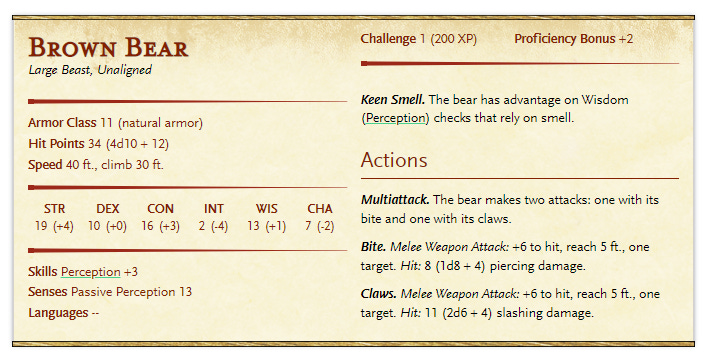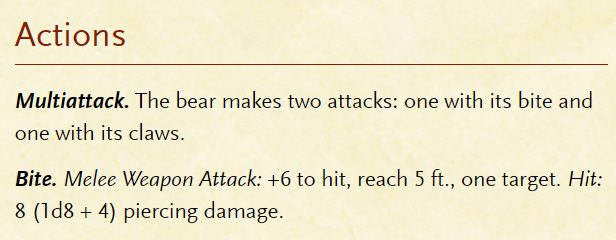I see most of the time GMs struggling with “balancing” when designing new enemies, trying to put an almost algorithmic formula in each of the monster’s “special skills”. And then, they spend more time trying to figure out the thin line between insta-kill damage and insignificant damage. Today, my friend, your suffering is over.
But before going any further, I will like to address something somebody must be thinking right now…
1. Bears suck. Period.
No, using the stat-block of a bear doesn’t solve problems, it hides them under the rug. Yes, it’s better than using the official material for each and every single monster out there.
For those who are unaware, there is a ““trick”” about using the stat-block of a bear in custom monsters, because of their generic stats and attacks. Most generic monsters have those attacks.
By using something like this, you are ignoring the root of the problem, that is…
2. …Unnecessary math
Let’s think a little: why do we roll dice? Because it’s fun? Not necessarily. Because it adds unpredictability and impartiality to the game. And that’s fun. Having a source of randomness makes the game more enjoyable. Having said that, let me ask another question:
Why the FUCK do we need THREE random sources to begin with? You don’t see it?
There it is. To perform an attack with this bear (or most monsters in D&D) you would have to roll to know:
if the attack hits
how much damage it does
“But where is the third random source?” you might ask. It’s in who is being hit. The player (or creature itself). Their max hit points are randomized too, you remember? To make things worse, the bear has multiattack.
So, for each turn, we need to roll 4 dices, to know what to subtract from a number generated from another set of dices. Why don’t just do it in one roll?
3. ❤️❤️❤️
Oh man, I love The Legend of Zelda.
I know it looks I have changed the subject of the article, but let me explain. D&D’s core combat rules are slow and full of unnecessary steps like we discussed in the previous chapter. We can make the resolution of an attack with only one random element.
Make every hit deal ONE damage, TWO with critical hits, big weapons or small explosions. Make every human have THREE hit points, or we can call it hearts.
So with this rule, you only roll to know if the attack hits. That’s four times faster than the D&D way of doing attacks.
Some questions might appear in your mind, so I will try to answer five of them here.
Q: I like to play tanks. How do I tank if I only have 3 hearts?
A: You still have items to increase your AC. Your class should also provide you with useful defensive skills.
Q: So Constitution is now useless?
A: No. Poison exists, magical effects exists. Constitution is more important than ever before, because now you can die.
Q: Would a paladin smite deal +1 damage? What about every other special ability?
A: You can increase your damage to TWO using your character sheet special abilities. You need to engage with the world, use the terrain to your advantage, to deal more damage.
Q: How much do I heal in a short rest?
A: Nothing. You only heal 1 heart after a long rest. Most magical sources of healing would recover 1 heart, and more powerful magic can regain 2 hearts.
Q: How much hearts would a bear have?
A: I would say 4, maybe 3 for a smaller bear.
There’s not much I have to say to convince you, you must try it in your table to see why it’s WAY better this way than the other way around. I can have a whole article explaining in detail why this method is so superior. Subscribe to the newsletter to receive a notification when this article comes up.
4. Chemistry and physics anomalies
A monster should break and bend rules of nature. Stop thinking about numbers, skill checks and that sort of stuff when designing a monster. Think about how he interacts with the world. I will tell you what kind of monsters I use for in my current campaign and how do I simplify them to only a few precise words.
Keep reading with a 7-day free trial
Subscribe to Mage's Hut to keep reading this post and get 7 days of free access to the full post archives.





